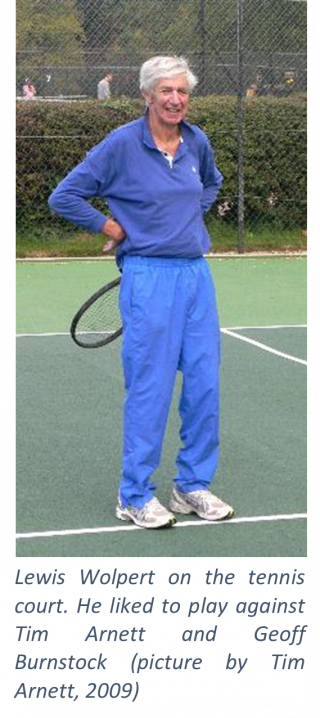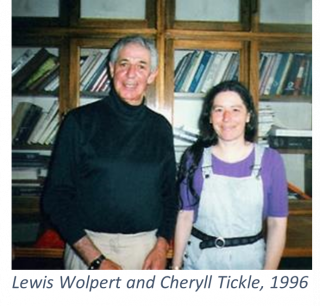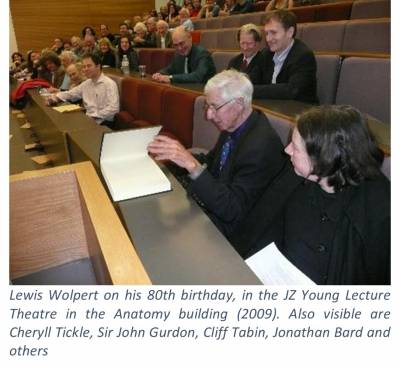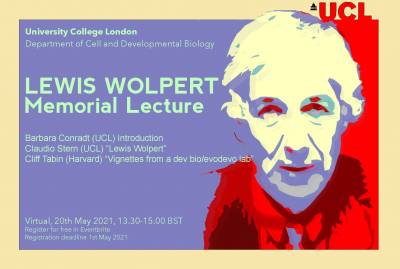Lewis Wolpert (19 October 1929 – 28 January 2021)
12 March 2021
A little over a month ago the Department lost one of its most famous (and colourful) members. Lewis Wolpert was a leading figure in developmental biology, whose ideas influenced many generations the world over.
In the field, he is perhaps best known for “The French Flag model” and the concept of “positional information” (both elaborated mainly in a well-known paper from 1969) and for the famous quote: “it is not birth, marriage or death but gastrulation which is truly the most important time in your life”. The former concepts were proposed to explain how individual cells within an embryo learn where they are relative to other cells, so that the whole tissue becomes “patterned” appropriately irrespective of the size of the embryo. The name of the model comes from the example of patterning a French Flag into its characteristic Red, White and Blue territories: a small flag and a big one will have the same proportions of each territory even though their sizes will differ.

One mechanism proposed by Wolpert is that a gradient of an informative molecule (“morphogen”) forms by diffusion from a source at one end, decreasing in concentration to the other end; cells then assess their position in the tissue based on the local concentration, in relation to fixed “thresholds” that will determine whether they differentiate into red, white or blue identities. The quote is one of many provocative statements which Lewis was very good at making, aimed to make our colleagues think – this quality, along with many public engagement lectures and several books, led to him being awarded the prestigious Michael Faraday Prize by the Royal Society in 2000 (given for public understanding of Science) and the Viktor Hamburger Outstanding Educator Prize by the Society for Developmental Biology (USA) in 2003.
Born in South Africa and initially educated as an engineer, Lewis then left South Africa in search of adventures, he hitchhiked up Africa and then to Israel. In 1954 he came to the UK to study soil mechanics at Imperial College. He then shifted his interests to cellular mechanics of cell division for his PhD with James Danielli at King’s College London, which later included a collaboration with Trygve Gustafson in Sweden on gastrulation in the sea urchin. He never looked back.
After some years at KCL, he set up his laboratory at the Windeyer Building of Middlesex Hospital Medical School (the building stood where the Sainsbury-Wellcome Centre is located now but occupied the entire block) where he led a relatively small department of “Biology as Applied to Medicine”. It was here that Lewis’s career in developmental biology took off.
His engineering and mathematical training allowed him to be active in modelling various developmental events, and was part of an influential group of theoretical biologists that included C.H. Waddington. But at the same time Lewis ran an experimental lab working on a range of model systems, especially concentrating on patterning of the chick limb to try to understand how the pattern of bones and digits forms correctly along all three axes of the limb, with the radial-distal axis being used as an example of a French Flag type of patterning event – his main collaborator on this for many years was Cheryll Tickle. Eventually other labs discovered that there is indeed a morphogen that underlies this effect, called Sonic hedgehog (SHH).

Lewis’s lab trained an extraordinary set of scientific “progeny” from his postdocs and PhD students, including Cheryll Tickle FRS, Julian Lewis FRS, Sir Jim Smith FRS (now Director of Strategy at the Wellcome Trust), our own former head Nigel Holder, among many others. When the Middlesex hospital was closed down, Lewis, along with some other members of his department including Cheryll Tickle, moved over to UCL into the department of Anatomy and Developmental Biology (now CDB). Although he no longer ran a lab in the Anatomy building, his mind remained very active almost until the end – reading, attending conferences, giving lectures, talking to colleagues, publishing prolifically (including many books) and increasingly taking part in public engagement.
I first came across Lewis in person when I visited his lab in 1974 in the top floor of the Windeyer building, looking for a place to do my PhD. I wanted to work on the limb and patterning but Lewis only offered me a project on patterning the mammary gland which I did not find very interesting so decided not to join him, but I distinctly remember the incredible buzz of the lab at the time as I met Cheryll, Julian and Jim among others on that day. I was very happy many years later (Jan. 2001), I came to UCL as Head of Anatomy & Developmental Biology to succeed Nigel Holder, I “acquired” Lewis as an affiliate to my own lab – he attended our lab meetings every Monday almost without fail, for at least 15 years. During this time I was able to provide a nice refurbished office for Lewis on the second floor of Anatomy, near where Roberto Mayor’s lab is now. At the lab meetings I got to see him “in action” as he inspired my own PhD students and postdocs. Lewis’s main quality was his ability to ask questions almost like a child – he had an uncanny ability to go straight to the core of the problem, cut out all the detail, and ask the “right” question (the most interesting and important one!).

In some cases, this led to ideas for “cool” experiments designed to answer them and eventually to some publications – the latest example is now in the final stages of preparation and I’m particularly sorry that he will not see it published, especially because it returns to the “French Flag” and the problem of how a large population of cells is patterned by morphogens.
Lewis wrote many books including a leading textbook of Developmental Biology, on the Cell, some to stimulate public understanding of Science, and on other topics including Depression (Malignant Sadness, 1999), based on many of his own experience of serious depression that started unexpectedly when he was 65, during an otherwise happy period of his life. He also wrote on Gender and on Belief. Although very respectful of the opinions and religious convictions of others, he was a committed atheist and humanist (and served as Vice-President and Patron of the British Humanist Association, now Humanists UK) and he believed that Science offers the best way to understand the world around us. In the last few years he was particularly thrilled to be awarded the Waddington medal by the British Society for Developmental Biology in 2015 and the Royal Society’s top medal, the Royal Medal, in 2018, and probably most of all, by the election of his son Daniel as FRS in 2012. Daniel is a neuroscientist, now at Columbia University in New York.
Lewis was universally liked by everyone because he was a wonderful, generous person. My theory is that this is in large part due to his child-like attitude to everything but when I put this to his wife Alison recently she said “oh no, Lewis always wanted to be a dog”, and pointed me to a part of his interview by Michael Berkeley for “Private Passions” on BBC Radio 3 in January 2014. But he had great trouble remembering anyone’s name, even many of those close to him, so his solution was to call everyone “my dear boy” or “my child”.
Lewis was in top form when Jim Smith and I organised a great party and symposium in his honour for his 80th birthday in 2009, held in the Anatomy Building, which was attended by many famous people from developmental biology, some having flown in from very remote countries.

In 2019, we celebrated his 90th birthday at the Royal Society with old friends, family and colleagues. Sadly, Lewis’s health had been deteriorating for a few years, and just as he was ending some treatments for consequences of a fall and preparing to go to a nursing home, he fell victim to COVID19 in January this year, at age 91.
Lewis is survived by his third wife Alison Hawkes and four children (Miranda, Daniel, Matthew and Jessica).
Claudio Stern, 4 March 2021
Register here for the UCL CDB Seminar: Lewis Wopert Memorial Lecture.

 Close
Close

